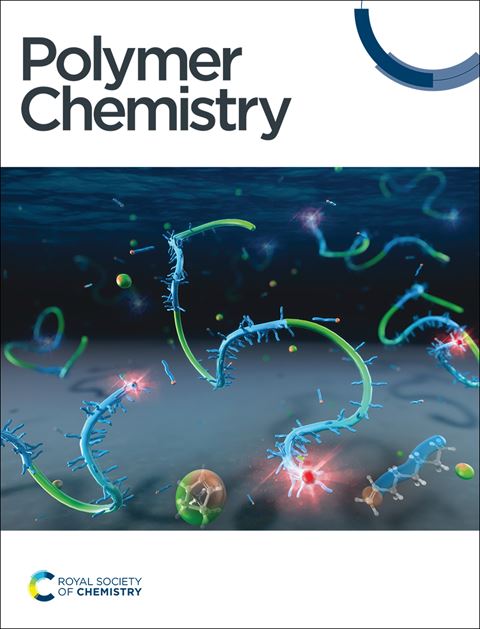亚胺键对可降解类胡萝卜素基共轭聚合物电子性能的影响
IF 4.1
2区 化学
Q2 POLYMER SCIENCE
引用次数: 0
摘要
类胡萝卜素是可降解π共轭聚合物的理想构建块,由于其固有的单分子电导和充分记录的降解途径。之前,我们报道了一种基于类胡萝卜素的聚合物p(cp -己基),它包含一个可切割的亚胺连接剂,可以通过酸水解或阳光降解;然而,人们对其电子特性的了解有限。在本研究中,我们比较了p(cp -己基)与结构类似物caro-PPV的光电和光物理性质,caro-PPV用乙烯基取代亚胺键,以改善电荷传输同时保持可降解性。紫外可见光谱(UV-Vis)、密度泛函理论(DFT)和瞬态吸收光谱(TA)为这些聚合物的光电特性提供了全面的了解。此外,利用FeCl3和三氟乙酸(TFA)对化学掺杂和氧化降解进行了评估,揭示了两种类胡萝卜素基聚合物自由基形成和降解机制的差异。最后,有机场效应晶体管(ofet)中的电荷载流子迁移率测量揭示了carlo - ppv优越的半导体性能,其迁移率是p(cp -己基)的103 -104倍。这些发现突出了类胡萝卜素单体在可降解电子产品π共轭聚合物设计中的潜力。本文章由计算机程序翻译,如有差异,请以英文原文为准。
Impact of imine bonds on the electronic properties of degradable carotenoid-based conjugated polymers
Carotenoids are ideal building blocks for degradable π-conjugated polymers due to their intrinsic single-molecule conductance and well-documented degradation pathways. Previously, we reported a carotenoid-based polymer, p(CP-hexyl), which incorporated a cleavable imine linker enabling degradation via acid hydrolysis or sunlight; however, there was limited insight into its electronic properties. In this current study, we compare the optoelectronic and photophysical properties of p(CP-hexyl) with a structural analog, caro-PPV, which replaces the imine bonds with vinylene groups, to improve charge transport while maintaining degradability. Ultraviolet-visible (UV-Vis) spectroscopy, density functional theory (DFT), and transient absorption (TA) spectroscopy provided a comprehensive understanding of these polymers’ optoelectronic properties. Further, chemical doping and oxidative degradation were evaluated using FeCl3 and trifluoroacetic acid (TFA), unveiling differences in radical formation and degradation mechanisms for both carotenoid-based polymers. Lastly, charge carrier mobility measurements in organic field-effect transistors (OFETs) unveiled caro-PPV’s superior semiconductor performance, with mobilities 103 -104 times greater than p(CP-hexyl). These findings highlight the potential of carotenoid monomers in the design of π-conjugated polymers for degradable electronics.
求助全文
通过发布文献求助,成功后即可免费获取论文全文。
去求助
来源期刊

Polymer Chemistry
POLYMER SCIENCE-
CiteScore
8.60
自引率
8.70%
发文量
535
审稿时长
1.7 months
期刊介绍:
Polymer Chemistry welcomes submissions in all areas of polymer science that have a strong focus on macromolecular chemistry. Manuscripts may cover a broad range of fields, yet no direct application focus is required.
 求助内容:
求助内容: 应助结果提醒方式:
应助结果提醒方式:


